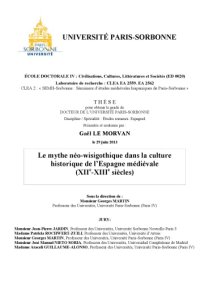
Ebook: Le mythe néo-wisigothique dans la culture historique de l’Espagne médiévale (XIIe-XIIIe siècles)
Author: Gaël Le Morvan
- Year: 2013
- Publisher: Université Paris-Sorbonne
- Language: French
- pdf
The study hereby presented tackles the origins of the kingdoms of León and Castile in the historic culture of medieval Spain (12th and 13th centuries). The aim is to understand the political bases of these kingdoms by analyzing a founding myth which emerged and took shape within the historiographical production in the north of the peninsula: the neo-Visigoth myth. A founding myth, this historic representation upholds the argument of an ethnic, dynastic, ideological and spiritual continuation between the Visigoth kingdom of Toledo, which collapsed in 711 when it was invaded by the Muslims, and the kingdoms of Léon and Castile. When recounting the stories of the reigns of Witiza and Rodrigo, the last Visigoth kings, and of the mythicised battles of the Guadalete and of Covadonga, chroniclers are manipulating views on history and slip interpolations which modify the meaning of their sources, thereby erasing any possibility of continuation between Rodrigo and Pelagius, the first restorer. Consequently, thanks to a discourse often tinged with providential undertones, the chroniclers help restoring the Hispanic country, which Saint Isidore of Seville defines in his work as the union of rex, gens and regnum, but they also contribute to endowing the political community with collective ethics, ideal values and role models. In addition, we would like to bring to light the contribution of historiography from the point of view of socio-historic semiology. The myth evolves according to the geopolitical context and each chronicler interprets their sources, thus overdoing and politicizing this legendary motif. These successive variations allow us to define the myth as an imaginary system revealing the intentio of the chroniclers or of their sleeping partners, but also as a doctrinal strategy of power, or even as the place for a profound ideological debate.
A source of legitimacy, the myth is re-used to serve the kingdoms being founded in the 12th century in the Historia legionensis (also known as silensis), the Chronica naiarensis and the Libro de las generaciones y linajes de los reyes (olim Liber regum) which champion ethnic and dynastic continuation in León, ideological continuation in Castile and territorial continuation in Navarre. In the 13th century, the myth turns into ideology. Estoria de España by Alphonso X the Wise inherits the historical vision of typically Leonese Chronicon mundi by Luc de Tuy and of typically Castilian De rebus Hispaniae by Rodrigue Jiménez de Rada, and a more comprehensive – even almost « national » – vision is associated to it with Poema de Fernán González. The Wise king then starts to see in the neo-Visigoth myth a means to legitimate his imperial claims both in Spain and in Europe.
A source of legitimacy, the myth is re-used to serve the kingdoms being founded in the 12th century in the Historia legionensis (also known as silensis), the Chronica naiarensis and the Libro de las generaciones y linajes de los reyes (olim Liber regum) which champion ethnic and dynastic continuation in León, ideological continuation in Castile and territorial continuation in Navarre. In the 13th century, the myth turns into ideology. Estoria de España by Alphonso X the Wise inherits the historical vision of typically Leonese Chronicon mundi by Luc de Tuy and of typically Castilian De rebus Hispaniae by Rodrigue Jiménez de Rada, and a more comprehensive – even almost « national » – vision is associated to it with Poema de Fernán González. The Wise king then starts to see in the neo-Visigoth myth a means to legitimate his imperial claims both in Spain and in Europe.
Download the book Le mythe néo-wisigothique dans la culture historique de l’Espagne médiévale (XIIe-XIIIe siècles) for free or read online
Continue reading on any device:

Last viewed books
Related books
{related-news}
Comments (0)